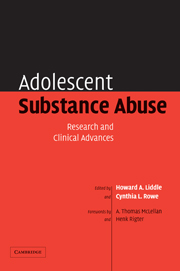Book contents
- Frontmatter
- Contents
- List of contributors
- Forewords
- Acknowledgements
- List of abbreviations
- 1 Treating adolescent substance abuse: state of the science
- Part I Theoretical, empirical, and methodological foundations for research in adolescent substance abuse treatment
- Part II Practice and policy trends in treatment for adolescent substance abuse
- 6 Epidemiological trends and clinical implications of adolescent substance abuse in Europe
- 7 The Drug Abuse Treatment Outcomes Studies: outcomes with adolescent substance abusers
- 8 Adolescent treatment services: the context of care
- 9 The principles of service organization and practice in England
- 10 Health services with drug-abusing adolescents: the next frontier of research
- Part III Comprehensive assessment and integrative treatment planning with adolescent substance abusers
- Part IV Empirically based interventions for adolescent substance abuse: research and practical implications
- Part V Culturally based treatment development for adolescent substance abusers
- Part VI Building the future
- Index
- References
6 - Epidemiological trends and clinical implications of adolescent substance abuse in Europe
from Part II - Practice and policy trends in treatment for adolescent substance abuse
Published online by Cambridge University Press: 26 August 2009
- Frontmatter
- Contents
- List of contributors
- Forewords
- Acknowledgements
- List of abbreviations
- 1 Treating adolescent substance abuse: state of the science
- Part I Theoretical, empirical, and methodological foundations for research in adolescent substance abuse treatment
- Part II Practice and policy trends in treatment for adolescent substance abuse
- 6 Epidemiological trends and clinical implications of adolescent substance abuse in Europe
- 7 The Drug Abuse Treatment Outcomes Studies: outcomes with adolescent substance abusers
- 8 Adolescent treatment services: the context of care
- 9 The principles of service organization and practice in England
- 10 Health services with drug-abusing adolescents: the next frontier of research
- Part III Comprehensive assessment and integrative treatment planning with adolescent substance abusers
- Part IV Empirically based interventions for adolescent substance abuse: research and practical implications
- Part V Culturally based treatment development for adolescent substance abusers
- Part VI Building the future
- Index
- References
Summary
Substance use and abuse are considered to be among the most common public health problems among adolescents in Europe (European Monitoring Centre for Drugs and Drug Addiction [EMCDDA], 2002). As shown by numerous studies, substance abuse is strongly associated with delinquency, poor scholastic attainment, suicide, and traffic accidents (e.g., BzgA [Federal Centre for Health Education] 2001; EMCDDA, 2002). The negative impact of drug and alcohol use in Europe has become increasingly more apparent in recent years. According to a recent report of the EMCDDA (2002), each year there are about 7000 to 8000 acute drug-related deaths in the European Union (EU). The estimated direct health-care cost of drug dependence and harmful use in the EU is enormous, with figures in the hundreds of millions of euros. Furthermore, a few million euros have been spent in preventing drug consumption and addiction. For example, during the fiscal year 2000, the German government allocated a total of 13.9 million euro for measures against the misuse of drugs and narcotics (Simon et al., 2001). In 2002, the budget spent on treatment, education, and model projects in the area of drugs and addiction in Germany was about 1 billion euro (Simon et al., 2001).
The increase in the prevalence and associated problems of substance abuse has prompted government support for several large-scale surveys of substance use and abuse. Most studies to date have, however, focused on adults and, less frequently, on adolescents (reviewed by Essau, Barrett, & Pasquali, 2002).
Information
- Type
- Chapter
- Information
- Adolescent Substance AbuseResearch and Clinical Advances, pp. 129 - 147Publisher: Cambridge University PressPrint publication year: 2006
References
Accessibility standard: Unknown
Why this information is here
This section outlines the accessibility features of this content - including support for screen readers, full keyboard navigation and high-contrast display options. This may not be relevant for you.Accessibility Information
- 14
- Cited by
